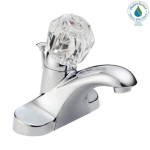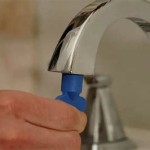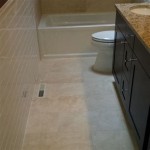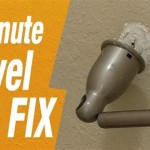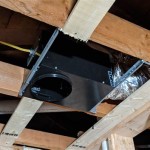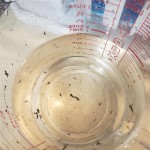Understanding Proper Bathroom Sink Drain Installation and Maintenance
The bathroom sink drain is a crucial component of any plumbing system, responsible for efficiently removing wastewater and preventing unpleasant odors from entering the living space. A properly installed and maintained drain minimizes the risk of leaks, clogs, and costly repairs. This article delves into the various aspects of proper bathroom sink drain installation, maintenance, and troubleshooting, providing a comprehensive understanding of this essential plumbing fixture.
The anatomy of a typical bathroom sink drain consists of several key parts: the tailpiece, the pop-up assembly (or strainer), the P-trap, and the drainpipe. The tailpiece connects directly to the sink basin and extends downwards. The pop-up assembly, controlled by a lever, allows the user to open and close the drain, retaining or releasing water as needed. The P-trap is a U-shaped pipe designed to hold a small amount of water, creating a barrier that prevents sewer gases from entering the bathroom. Finally, the drainpipe connects the P-trap to the main drain line in the wall.
Key Point 1: Installation Procedures and Best Practices
Proper installation is paramount for ensuring the functionality and longevity of a bathroom sink drain. Incorrect installation can lead to leaks, slow drainage, and premature component failure. The following steps outline best practices for installing a new bathroom sink drain:
Step 1: Preparation and Component Verification. Before beginning the installation process, gather all necessary tools and materials. These typically include adjustable wrenches, pliers, plumber's putty, Teflon tape, a bucket, and a clean rag. Carefully inspect all drain components for any signs of damage or defects. Ensure that all parts are present and compatible with the sink and drainpipe.
Step 2: Removing the Old Drain. If replacing an existing drain, begin by shutting off the water supply to the sink. Disconnect the tailpiece from the P-trap using adjustable wrenches. Place a bucket underneath to catch any residual water. Loosen the nut securing the pop-up assembly to the sink basin from beneath the sink. Once the nut is removed, the old drain assembly can be carefully lifted out of the sink.
Step 3: Installing the New Pop-Up Assembly. Clean the sink drain opening thoroughly, removing any old plumber's putty or debris. Roll a rope of plumber's putty and apply it evenly around the underside of the new pop-up assembly flange, where it will contact the sink basin. Insert the pop-up assembly into the drain opening from above. From beneath the sink, install the rubber and fiber washers in the correct order, followed by the mounting nut. Tighten the mounting nut by hand until snug, then use adjustable wrench to tighten it another quarter turn. Avoid overtightening, as this can crack the sink.
Step 4: Connecting the Tailpiece and P-Trap. Attach the tailpiece to the bottom of the pop-up assembly, ensuring that the washers are correctly positioned inside the connection nut. Tighten the nut securely by hand. Assemble the P-trap components, ensuring the slip joints are properly aligned. Connect the P-trap to the tailpiece and the drainpipe in the wall. Tighten all slip joint nuts by hand until snug. Ensure that the P-trap is oriented correctly to hold water and prevent sewer gas from escaping.
Step 5: Testing for Leaks. Once the drain is fully assembled, turn on the water supply and allow the sink to fill partially. Carefully inspect all connections for leaks. If any leaks are detected, tighten the corresponding nut slightly. If the leak persists, disassemble the joint, inspect the washers, and reassemble, ensuring proper alignment. Repeat the leak test until all connections are watertight.
Using plumber’s putty correctly is crucial. Apply it generously but neatly, ensuring a complete seal between the drain flange and the sink basin. Teflon tape should be used on threaded connections to prevent leaks. Wrap the tape clockwise around the threads several times before connecting the components.
Key Point 2: Common Drain Problems and Troubleshooting
Despite proper installation, bathroom sink drains can experience various problems over time. Common issues include clogs, slow drainage, leaks, and unpleasant odors. Being able to diagnose and address these problems promptly can prevent more serious damage and maintain a functional plumbing system.
Clogs: Clogs are perhaps the most frequent problem encountered with bathroom sink drains. They are typically caused by the accumulation of hair, soap scum, toothpaste, and other debris. Slow drainage is often the first sign of a developing clog. To clear a clog, start by removing the pop-up stopper and cleaning away any visible debris. A bent wire or hook can be used to extract hair and other obstructions from the drain. If the clog persists, a plunger can be used to create pressure and dislodge the blockage. Ensure there is enough water in the sink to cover the cup of the plunger for effective plunging.
If plunging is unsuccessful, consider using a drain snake, also known as an auger. Insert the snake into the drain opening and rotate it as you push it deeper into the pipe. The snake will break up or retrieve the clog. Once the snake has reached the obstruction, continue rotating and retracting it until the blockage is removed. After removing the clog, flush the drain with hot water to ensure it is clear.
Chemical drain cleaners are another option, but should be used with caution. These cleaners can be corrosive and may damage the pipes if used excessively. Always follow the manufacturer's instructions carefully and wear protective gloves and eyewear when handling chemical drain cleaners. As a preventive measure, avoid pouring grease, oil, or coffee grounds down the drain, as these materials can contribute to clogs.
Leaks: Leaks can occur at various points in the drain assembly, including connections between the tailpiece, P-trap, and drainpipe. Identifying the source of the leak is the first step in addressing the problem. Check all slip joint nuts for tightness. If a nut is loose, tighten it securely by hand or with an adjustable wrench. If the leak persists, disassemble the joint, inspect the washers for damage or deterioration, and replace them if necessary. Apply Teflon tape to threaded connections to ensure a watertight seal. In some cases, the drainpipe itself may be cracked or damaged, requiring replacement.
Odors: Unpleasant odors emanating from the bathroom sink drain are often caused by sewer gases escaping through the P-trap. This can occur if the P-trap has dried out due to infrequent use, allowing sewer gases to bypass the water barrier. To remedy this, simply run water down the drain for a few minutes to refill the P-trap. Another cause of odors is the accumulation of organic matter within the drainpipe. Regular cleaning with a mixture of baking soda and vinegar can help to eliminate these odors. Pour one cup of baking soda down the drain, followed by one cup of vinegar. Allow the mixture to fizz for 30 minutes, then flush the drain with hot water.
Key Point 3: Maintenance Tips for Long-Term Drain Health
Preventative maintenance is essential for ensuring the long-term health and functionality of the bathroom sink drain. Regular cleaning and inspection can help to prevent clogs, leaks, and other problems, extending the lifespan of the drain components.
Regular Cleaning: To prevent clogs, clean the pop-up stopper and drain opening regularly. Remove any visible debris, such as hair and soap scum. Flush the drain with hot water after each use to help prevent the accumulation of residue. Periodically, pour boiling water down the drain to dissolve grease and soap buildup. Use a mixture of baking soda and vinegar monthly to help maintain a clean drain. Allow the mixture to sit for 30 minutes, then flush with hot water.
Inspection and Tightening: Inspect the drain assembly regularly for leaks or signs of damage. Check all slip joint nuts for tightness and tighten them as needed. Replace any worn or damaged washers or gaskets promptly. Look for signs of corrosion or rust on the drainpipe and replace any corroded sections. Consider using a hair strainer in the drain opening to catch hair and prevent it from entering the drainpipe. These strainers are inexpensive and easy to install.
Professional Assistance: While many drain problems can be addressed with DIY methods, it is sometimes necessary to seek professional assistance. If you are unable to clear a persistent clog, or if you suspect a more serious plumbing issue, such as a damaged drainpipe or a problem with the main drain line, contact a qualified plumber. A plumber has the expertise and tools necessary to diagnose and repair complex plumbing problems safely and effectively.
By adhering to these installation and maintenance guidelines, homeowners can ensure the proper functioning and longevity of their bathroom sink drains.

How To Plumb A Bathroom With Multiple Plumbing Diagrams Hammerpedia
How To Install Bathroom Sink Drain Queen Bee Of Honey Dos

4 Ways To Seal A Sink Drain Pipe

How To Plumb A Bathroom With Multiple Plumbing Diagrams Hammerpedia

How To Install A Pipe From Sink Drain Wall Ehow

The 10 Most Common Plumbing Mistakes Diyers Make

How To Easily Connect The Plumbing For A New Bathroom Sink Hometips

How To Plumb A Bathroom With Multiple Plumbing Diagrams Hammerpedia

Replace A Trap And Add Cleanout Fine Homebuilding
How To Install Bathroom Sink Drain Queen Bee Of Honey Dos
Related Posts
